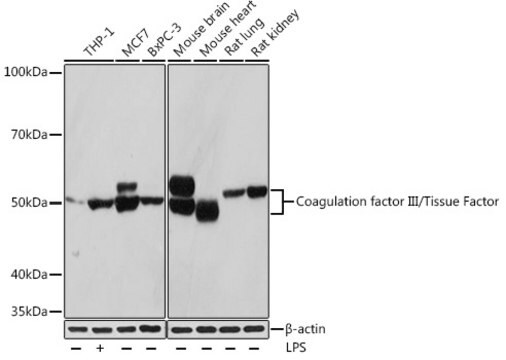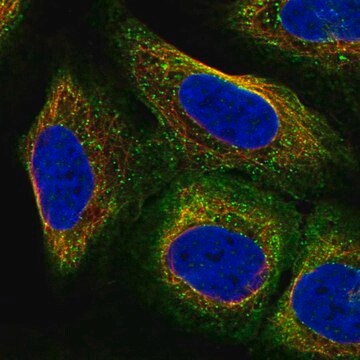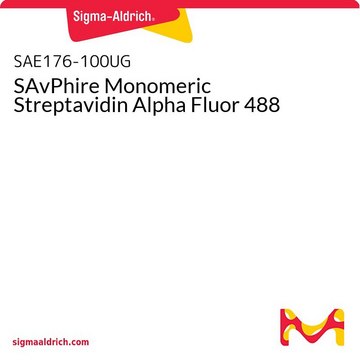推薦產品
生物源
mouse
品質等級
抗體表格
purified antibody
抗體產品種類
primary antibodies
無性繁殖
HTF-1, monoclonal
分子量
calculated mol wt 33 kDa
observed mol wt ~42-48 kDa
純化經由
using protein G
物種活性
human, bovine
包裝
antibody small pack of 100
技術
ELISA: suitable
dot blot: suitable
flow cytometry: suitable
immunohistochemistry: suitable
inhibition assay: suitable
western blot: suitable
同型
IgG1κ
表位序列
Unknown
Protein ID登錄號
UniProt登錄號
儲存溫度
-10 to -25°C
基因資訊
human ... F3(2152)
特異性
Clone HTF-1 is a mouse monoclonal antibody that specifically detects Tissue Factor/CD142 protein.
免疫原
Full length native (purified) human Tissue Factor.
應用
Immunofluorescence Microscopy
Tissue factor: Identification and characterization of cell types in human placentae. (Faulk, W.P., C.A. Labarrere, and S.D. Carson. (1990). Blood 76:86-96).
Immunofluorescent studies of tissue factor on U87MG cells: Evidence for non-uniform distribution. Carson, S.D., and S.J. Pirruccello. (1993). Blood Coagulation and Fibrinolysis 4:911-920).
Flow Cytometry
Tissue factor antigen and activity are not expressed on the surface of intact cells isolated from an acute promyelocytic leukemia patient. (Carson, S.D., S.J. Pirruccello, and W.D. Haire. (1990). Thrombos. Res. 59:159-170).
Immunohistochemistry
Participation of cell-mediated immunity in the deposition of fibrin in glomerulonephritis. (Neale, T.J., P.G. Tipping, S.D. Carson, and S.R. Holdsworth. (1988). Lancet, No. 8606, 2:421-424).
Tissue factor antigen in senile plaques of Alzheimer′s disease. (McComb, R.D., K.A. Miller, and S.D. Carson. (1991). Am. J. Path. 139:491-494).
Immunoaffinity purification of the tissue factor protein
An inhibitory monoclonal antibody against human tissue factor. (Carson, S.D., S.E. Ross, R. Bach, and A. Guha. (1987). Blood 70:490-493).
Tissue factor: Identification and characterization of cell types in human placentae. (Faulk, W.P., C.A. Labarrere, and S.D. Carson. (1990). Blood 76:86-96).
Immunofluorescent studies of tissue factor on U87MG cells: Evidence for non-uniform distribution. Carson, S.D., and S.J. Pirruccello. (1993). Blood Coagulation and Fibrinolysis 4:911-920).
Flow Cytometry
Tissue factor antigen and activity are not expressed on the surface of intact cells isolated from an acute promyelocytic leukemia patient. (Carson, S.D., S.J. Pirruccello, and W.D. Haire. (1990). Thrombos. Res. 59:159-170).
Immunohistochemistry
Participation of cell-mediated immunity in the deposition of fibrin in glomerulonephritis. (Neale, T.J., P.G. Tipping, S.D. Carson, and S.R. Holdsworth. (1988). Lancet, No. 8606, 2:421-424).
Tissue factor antigen in senile plaques of Alzheimer′s disease. (McComb, R.D., K.A. Miller, and S.D. Carson. (1991). Am. J. Path. 139:491-494).
Immunoaffinity purification of the tissue factor protein
An inhibitory monoclonal antibody against human tissue factor. (Carson, S.D., S.E. Ross, R. Bach, and A. Guha. (1987). Blood 70:490-493).
Quality Control Testing
Evaluated by Western Blotting in A-431cell lysate.
Western Blotting Analysis: A 1:500 dilution of this antibody detected Tissue Factor/CD142 in A-431 cell lysate.
Tested Applications
ELISA Analysis: A representative lot detected Tissue Factor/CD142 in ELISA applications (Carson, S.D., et al. (1987). Blood. 70(2):490-3).
Western Blotting Analysis: A representative lot detected Tissue Factor/CD142 in Western Blotting applications (Carson, S.D., et al. (1987). Blood. 70(2):490-3). .
Dot Blot: A representative lot detected Tissue Factor/CD142 in Dot Blot applications (Carson, S.D., et al. (1987). Blood. 70(2):490-3).
Inhibition Assay: A representative lot detected Tissue Factor/CD142 in Inhibition applications (Carson, S.D., et al. (1987). Blood. 70(2):490-3).
Note: Actual optimal working dilutions must be determined by end user as specimens, and experimental conditions may vary with the end user.
Evaluated by Western Blotting in A-431cell lysate.
Western Blotting Analysis: A 1:500 dilution of this antibody detected Tissue Factor/CD142 in A-431 cell lysate.
Tested Applications
ELISA Analysis: A representative lot detected Tissue Factor/CD142 in ELISA applications (Carson, S.D., et al. (1987). Blood. 70(2):490-3).
Western Blotting Analysis: A representative lot detected Tissue Factor/CD142 in Western Blotting applications (Carson, S.D., et al. (1987). Blood. 70(2):490-3). .
Dot Blot: A representative lot detected Tissue Factor/CD142 in Dot Blot applications (Carson, S.D., et al. (1987). Blood. 70(2):490-3).
Inhibition Assay: A representative lot detected Tissue Factor/CD142 in Inhibition applications (Carson, S.D., et al. (1987). Blood. 70(2):490-3).
Note: Actual optimal working dilutions must be determined by end user as specimens, and experimental conditions may vary with the end user.
標靶描述
Tissue factor (UniProt: P13726; also known as TF, Coagulation factor III, Thromboplastin, CD142) is encoded by the F3 gene (Gene ID: 2152) in human. Tissue factor (TF) is an integral membrane protein that serves as a high-affinity receptor and cofactor for factor VII/VIIa. It is expressed on perivascular cells and epithelial cells at organ and body surfaces where it forms a hemostatic barrier. It is also reported to provide hemostatic protection to brain, lung, and heart. In normal healthy individuals, levels of TF are very low. Cell-surface levels of TF do not display any directly correlation with its procoagulant activity indicating that TF exists on the cell surface as dormant (encrypted) and active (de-encrypted) form. This allows for a rapid hemostatic response without a need for transcriptional upregulation of the F3 gene. TF normally exists in a partially encrypted state and its de-encryption on circulating monocytes, platelets or endothelial cells by inflammatory mediators can lead to thrombosis. It initiates blood coagulation by forming a complex with circulating factor VII or VIIa and this complex activates factor IX and X by specific, limited proteolysis. TF expression by nonvascular cells plays an essential role in homeostasis; however, TF expression by vascular cells can induce life-threatening intravascular thrombosis in various diseases, such as sepsis, cancer, and atherosclerosis. Inhibition of TF-Factor VIIa activity is shown to reduce coagulation and mortality in animal models of sepsis. Many cancer cells express large amounts of TF, which contributes to tumor angiogenesis and growth. Cancer cells can release TF-positive microparticles into the circulation that can trigger venous thromboembolism. TF on circulating tumor cells can also coat cells with fibrin that traps them within the microvasculature and promote hematogenous metastasis. (Ref.: Carson, S.D., et al. (1987). Blood. 70(2):490-3; Caldwell, JA., et al. (2010). Lab. Invest. 90; 953-962; Kasthuri, RS., et al. (2009). J. Clin. Oncol. 27(29); 4834-4838; Mackman, N. (2004).
外觀
Purified mouse monoclonal antibody IgG1 in PBS without azide.
重構
0.5 mg/mL. Please refer to guidance on suggested starting dilutions and/or titers per application and sample type.
儲存和穩定性
Store at -10°C to -25°C. Handling Recommendations: Upon receipt and prior to removing the cap, centrifuge the vial and gently mix the solution. Aliquot into microcentrifuge tubes and store at -20°C. Avoid repeated freeze/thaw cycles, which may damage IgG and affect product performance.
其他說明
Concentration: Please refer to the Certificate of Analysis for the lot-specific concentration.
免責聲明
Unless otherwise stated in our catalog or other company documentation accompanying the product(s), our products are intended for research use only and are not to be used for any other purpose, which includes but is not limited to, unauthorized commercial uses, in vitro diagnostic uses, ex vivo or in vivo therapeutic uses or any type of consumption or application to humans or animals.
未找到適合的產品?
試用我們的產品選擇工具.
儲存類別代碼
12 - Non Combustible Liquids
水污染物質分類(WGK)
WGK 2
閃點(°F)
Not applicable
閃點(°C)
Not applicable
分析證明 (COA)
輸入產品批次/批號來搜索 分析證明 (COA)。在產品’s標籤上找到批次和批號,寫有 ‘Lot’或‘Batch’.。
我們的科學家團隊在所有研究領域都有豐富的經驗,包括生命科學、材料科學、化學合成、色譜、分析等.
聯絡技術服務







